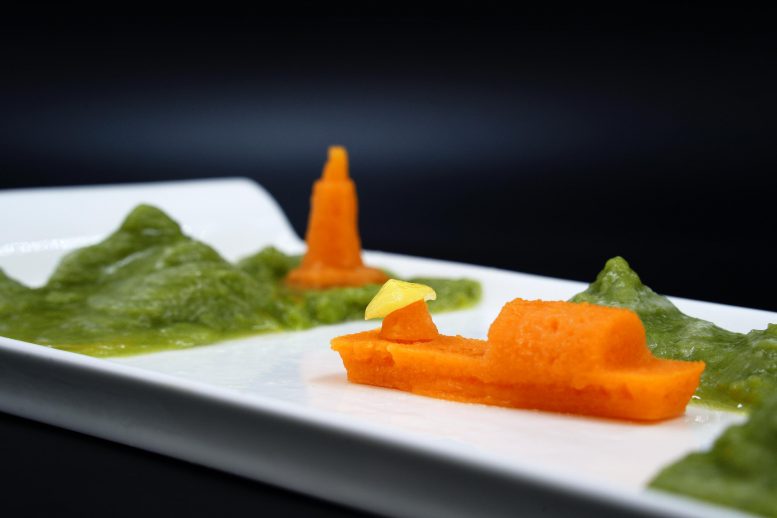
Singapore researchers develop new method for ‘printing’ fresh vegetables, leading to tastier, more nutritious food for patients with swallowing difficulties.
Researchers from Nanyang Technological University, Singapore (NTU Singapore), Singapore University of Technology and Design (SUTD) and Khoo Teck Puat Hospital (KTPH) have developed a new way to create “food inks” from fresh and frozen vegetables, that preserves their nutrition and flavor better than existing methods.
Food inks are usually made from pureed foods in liquid or semi-solid form, then 3D-printed by extrusion from a nozzle, and assembled layer by layer.
Pureed foods are usually served to patients suffering from swallowing difficulties known as dysphagia. To present the food in a more visually appetizing way, healthcare professionals have used silicone molds to shape pureed foods, which is labor and time intensive, and requires storage.
While 3D food printing means food can be easily produced in a desired shape and texture in a shorter time, the dehydrated food and freeze-dried powders used as food inks usually contain a high percentage of food additives such as hydrocolloids (HCs) to stabilize the ink and enable a smoother printing process. High concentration of HCs usually changes the taste, texture, and aroma of the printed food, making it unappetizing to patients with dysphagia. This may lead to reduced food consumption and malnutrition among patients.
To overcome this challenge, the research team explored various combinations of fresh and frozen vegetables to make the food inks stable.
Not only were they able to better preserve the nutrition of the printed food, they also made it more palatable. This new method of making food inks should lead to increased meal consumption by patients, contributing positively to their physical health and mental state of mind.

Additionally, the team discovered that vegetables could be broadly classified into three categories with each requiring a different hydrocolloid treatment in order to become printable. For instance, garden pea, carrot, and bok choy were chosen as representatives in each category, requiring no HCs, one type of HC and two types of HCs, respectively (refer to images).
Prof Yi Zhang, the principal investigator from the NTU team said, “Our technology helps to provide dysphagic patients with adequate nutrient-rich and safe diets. Their feeding is more dignified, enabling them to socialize and consume meals that look, feel and taste like regular food. Our method of 3D printing fresh vegetables can be used easily in hospitals, nursing homes, daycare centers for the aging population with dysphagia and other swallowing disorders. Our research is also another step forward in digital gastronomy, where we can cater to specific requirements prescribed by dieticians, such as nutrition customization and visual appeal.”
Prof Chua Chee Kai, corresponding author and the Head of Pillar, Engineering Product Development at SUTD, added: “The next frontier of additive manufacturing is 3D food printing. As the 3D food printing landscape is increasingly evolving, we are excited to continue pushing the boundaries of this industry to find innovative solutions for global issues such as food security and sustainability.”
Gladys Wong, co-principal investigator and Senior Principal Dietitian from KTPH said: “3D Food Printing is more than a novelty. I believe it will be a viable approach in the near future in providing sustenance and nourishment to our increasing aging population. Our frail, elderly patients as well as those with swallowing difficulties will be able to enjoy a visually presentable and pleasurable dining experience even with a restrictive diet of smooth pureed dishes.”
Reference: “3D food printing of fresh vegetables using food hydrocolloids for dysphagic patients” by Aakanksha Pant, Amelia Yilin Lee, Rahul Karyappa, Cheng Pau Lee, Jia An, Michinao Hashimoto, U-Xuan Tan, Gladys Wong, Chee Kai Chua and Yi Zhang, 17 December 2020, Food Hydrocolloids.
DOI: 10.1016/j.foodhyd.2020.106546
Funding: National Additive Manufacturing Innovation Cluster Project, National Research foundation Singapore